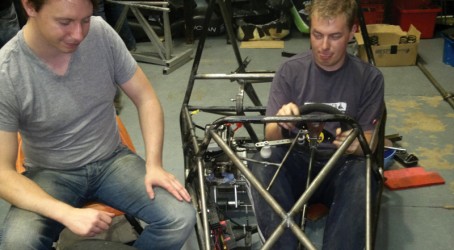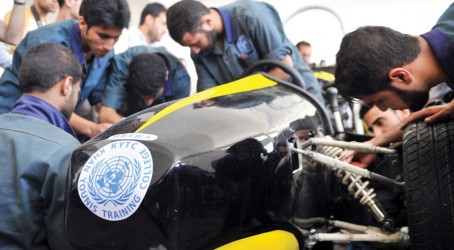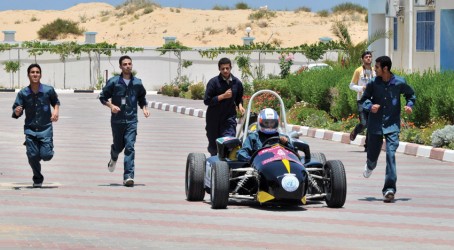Later this month, hundreds of budding engineers will gather at the Silverstone racetrack in Northamptonshire to take part in what has become one of the most important motorsport events in the world.
Formula Student will see 125 teams from universities located as far afield as Egypt, Nigeria, Thailand, Russia and Australia compete to race single-seater cars that they have spent the past year designing and building. The cars will be judged on their speed, acceleration and endurance around the Silverstone circuit. The teams themselves will be tested on their design, costing and business presentation skills.
As well as being a lot of fun, Formula Student gives the youngsters taking part the chance to put their automotive engineering skills in the shop window. The competition is regularly attended and judged by top engineers from companies such as Jaguar Land Rover (JLR), Lotus, Renault and Mercedes Petronas, and in the past it has acted as a hotbed of industry recruitment. And the competition also fulfils an important technological role: the participating teams often test new powertrain systems and equipment, so Formula Student has won a reputation as a valuable testing ground for automotive innovation.
This year is no exception, with the sustainable, fuel-efficient class 1A category attracting 16 entrants from all parts of the globe. Class 1A has been designed so that teams develop novel powertrain technologies that result in race cars with low-carbon emissions. The static part of the class includes design and business presentations, but the cost event is replaced by a sustainability theme where the teams must determine the CO2 emissions and energy levels of the vehicles. The cars will also compete in the same dynamic events as the class 1 vehicles.
The category will be judged and scored separately from the existing class 1 with a much greater emphasis on carbon emissions, as measured during the endurance component of the track schedule.
The development of 1A in addition to the existing classes reflects the fact that Formula Student needs to move with the times, and that many of the young engineers involved will be expected to work on low-carbon projects when they embark on their careers. Jon Hilton, chairman of Formula Student and managing partner of Flybrid Systems, the energy storage company, says that the rule changes will ensure that the event stays relevant.
“Formula Student is more popular than ever,” he says. “But over the years that we have been running it in the UK the rules have been very stable, bar the odd tweak here and there. People often say if it isn’t broke don’t fix it – but it’s important for the competition to evolve. So class 1A sets a new challenge. And what we have found is that some of the universities that have been involved with the competition for a long time and have been previously successful have got a high number of entries in the new class. It’s obvious that they are keen to try something different.”
Hilton insists that class 1A will add an exciting new element to the event. “There are not many other events such as Formula Student where budding engineers get the chance to design, build and test their work in such a dramatic fashion,” he says. “Universities don’t tend to give their students as much responsibility as they get at FS.
“It’s good for members of the IMechE too – we have more than 100 members who act as volunteers, and there are key industry partners such as Jaguar Land Rover and Mercedes-Benz who are looking to attract the best talent.”

Class 1A is for alternative powertrains. The organisers have given students as much freedom as possible to design the type of car that they think will perform best – albeit within set criteria. The organisers have been clear not to prescribe what the technological answer should be. And that has provoked some innovative responses from the participating teams, with hydrogen-burning reciprocating engines, fuel cells, electric vehicles, electric hybrids, and bioethanol vehicles among the entrants.
But it’s very much not about creating a green car that is slow – the organisers have been keen to stress that class 1A cars need to have a balance of performance and economy, and the judging criteria will reflect that. “There will be rigorous analysis of the design reports that have been submitted, where we probe the students’ understanding of the car to ensure that the tutor hasn’t done all the work,” he says.
“Then there will be a business case presentation, which is expected to look at issues such as cost and sustainability. And in the dynamic there will be different competitions including single-lap sprints, figure-of-eight lateral G tests, and endurance events. It’s about establishing a car that blends performance and endurance with good fuel consumption.”
Class 1A has attracted entries from around the world. They include teams from Delft University of Technology in the Netherlands, ETH Zurich in Switzerland, Imperial College London, Slovak University of Technology in Slovakia, TU Darmstadt in Germany, and the University of Iceland. In each case, it’s fair to say that all of the designs have required more thought and more engineering than standard petrol cars.
The alternative powertrains have required additional vehicle integration, with electric drive systems, for instance, having to be built into the cars in a safe and controllable manner. Weight has also been a struggle, with the requirement for new components having had a potential impact on performance.
It was those sorts of challenges that encouraged a team from the University of Central Lancashire (UCLan) to enter class 1A with an E85 ethanol-blend vehicle. James Isherwood, team leader on the UCLan project, says the additional complexity of the 1A class has really stretched the engineering students on the team.
He says: “From our point of view, building a truly sustainable car has required us to concentrate on three different areas – the build, the running of it, and the disposal. It requires a full lifecycle approach.
“That has been a real challenge – because we wanted to be as green as possible. So as well as doing things like improving the performance of the chassis by playing around with triangulation points, we have been forced to consider lifecycle aspects when selecting materials. So on the bodywork we have made panels using basalt-based fibres. And we have looked at other materials such as hessian and jute. It’s about making the car as sustainable as possible without impacting on its performance.”
The UCLan car features a standard combustion engine that can run on E85 ethanol-blend fuel. Isherwood says this combination provided the team with the best possible option when it came to considering the full lifecycle. “When we looked into it, electric or hydrogen cars could not compete with E85 because of all the energy that would have had to have gone into making components like batteries,” he says. “And then there would have been disposal problems afterwards. When looking at full lifecycle performance, the E85 variant wiped the floor with all of them.”
The biggest challenge, says Isherwood, was the tight timescales for building the car. “We’ve only had two months to build the car from scratch,” he says. “That has been the hardest part as we are making most of the parts in-house. With the suspension, for instance, we have machined the wishbones and all of the brackets ourselves. The manufacturing side of the project takes a long time to get right.”
The experience that students such as Isherwood gain from taking part in Formula Student is likely to stand them in good stead for the future. That was certainly the case for Will Ashford, who competed in the event in 2002 and 2004 while studying for a BEng in automotive engineering at the University of Hertfordshire. He says it provided an “awesome” experience, but admits that taking part took a lot of time and commitment that came on top of his degree studies.
“We worked round the clock on our car, and it wasn’t unheard of to wake up after sleeping on the workshop floor,” he says. “But it was worthwhile because getting involved in the event gave me invaluable hands-on experience – it really taught me about working as part of a team.
“There is no good building a car that has a great chassis if it doesn’t have an equally great engine. Everybody depends on everyone else, and I remember getting quite emotional when I felt people weren’t pulling their weight.”
Ashford says that Formula Student was also a good way of transferring what had been learned in the classroom into a real-world environment: “Theory is great, but you need to be able to put things into practice. The competition gave me a much better idea of what it meant to design for manufacture.”
Ashford now works as a project management consultant for Pcubed, the programme and project management consultancy. But his links to Formula Student haven’t disappeared. Pcubed recognises the value of the competition and is involved with the judging of some of the design and static events. In return, the company gets to meet some of the brightest young automotive engineers who are working their way through university.
“It’s a great feeding ground for the right calibre of people,” he says. “I love going back and getting involved. I still get a buzz from the noise, the smell of the rubber and the sight of the cars whizzing round the track. And I never fail to be amazed at some of the technologies that the students design and build.
“It’s so much more than a few kids racing go-karts. Some of these vehicles can give Formula One cars a run for their money.”
Blood, sweat and tears
The success of Jaguar Land Rover over recent years means that the company is expanding rapidly. It is taking on 250 engineering graduates this year, as well as over 100 apprentices. There will be 40 new vehicles, powertrain upgrades and body/trim changes on existing vehicles over the next five years.
Jose Lopes is head of technical excellence at Jaguar Land Rover, a role that sees him charged with ensuring that the carmaker has the right skills and competencies. He sees Formula Student as a crucial recruiting ground for the next generation of engineering talent.
“Jaguar Land Rover is a partner sponsor of Formula Student for two primary reasons,” he says. “Firstly, it’s vital for recruitment. It’s a very important showcase for automotive engineering skills. The event is a chance for the students to really prove themselves, and I’m always amazed at the levels of ingenuity on display and the sorts of technologies that are developed.
“Secondly, it’s important for companies like Jaguar Land Rover to promote engineering. Industry still has a way to go in terms of helping to change the perception of engineering from oily rags and spanners to high-technology advanced manufacturing. We have a responsibility to support initiatives such as Formula Student and to encourage people to enter the profession.”
Lopes is enthused by the emergence of class 1A. He says it will help to produce engineers with the sorts of skills that industry needs. “The low-carbon agenda is transforming the industry. We need young people coming through with the skills to drive new programmes.”
And Lopes enjoys Formula Student because he finds it an exciting day out. “The creativity of those involved always surprises me,” he says.
“And there’s a real variety among the teams. Some have obviously attracted a lot of sponsorship and produce some very professional-looking vehicles. Others have had less money to spend and have spent blood, sweat and tears to get their car to compete. It’s a real showcase for talent and dedication.”
From Gaza to Silverstone: Palestinian students build race car from scratch
Engineering students from the Gaza Strip have built a single-seat racing car to compete in the Formula Student event at Silverstone, despite a five-year blockade on the territory.
The Israeli blockade has meant that the students, from the UN-run Khan Younis Training College (KYTC) in Gaza, have had to use almost entirely recycled parts to build the car – such as water pipes for the chassis and an engine salvaged from an old motorbike.
Nineteen-year-old Osama Al Othmani, the KYTC team leader, says: “We are challenging all the pressures here, and the blockade. We want to prove to the world that, even if we are living on nothing, we can still create something from it.
“The last thing we will do is to stick on the label. It will say: Made in Gaza.”
Dr Colin Brown, director of engineering at the Institution of Mechanical Engineers, says: “It is inspirational to see a team working so hard with the odds stacked against them like this. Formula Student is a massive challenge in its own right, but to be working with almost entirely recycled parts in one of the most deprived areas in the world is remarkable. These students epitomise the spirit and inventiveness of those who take part in Formula Student.”
While most of the other teams at Formula Student have attracted big-name sponsors and recruiters from Formula One, the prospects for young engineers without the opportunity to leave Gaza are bleak. KYTC’s budding engineers, many of whom are living on less than £2 a day, will be lucky to become garage mechanics, earning a maximum of £200 a month. But still the team have worked around the clock to make sure that the car is ready for the event. Dr Ghassan Abu Orf, the team’s supervisor, says: “They have taken no rest – we don’t have that much time. We have to stick to the deadline, and have to be in the UK on time for the competition.”

